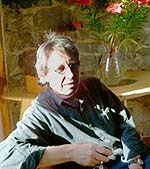Having the opportunity as a youngster to spend my summers in the forests and lakes of Northern Michigan I'm sure has affected what I'm doing right now. I remember being in the forest and playing with sticks, assembling them, and liking the feeling of being with the trees.
Wood designer-maker Peter Costello

I turned to furniture mid-career. I was actually trained as a musician and a high school teacher and I decided to do something else. I'd done a lot of building before and I suddenly decided to build stuff that I was going to sell instead of keep. The loveliest feeling for someone like me is when it goes out the door and is delivered to where it's going and a cheque comes in.
Living in Tasmania makes for a sort of independence. It's on the fringes of the world. A lot of interesting things happen on the fringes. There's an independence of thought.
I use almost exclusively plywood, very high quality plywood marine ply. And on to it I lay some special veneers. I use veneers on ply rather than solid wood. Plywood is an enormously strong material. It has properties that solid wood doesn't have. It can be bent, twisted and contorted. It gives a piece a kind of excitement when there's a bend in it. Sometimes I fancy can see a kind of shimmering light around it. Plywood is very suitable for that kind of use.
I try and keep the work very simple. Each piece needs to be predicated by one idea only. If it has two good ideas in the piece it's one good idea too many. It becomes too busy, uncentred, so I work entirely on a single idea. Everything that goes into making the piece is built up to bring that idea out.
The ideas usually come very quickly. I believe that almost any idea will do. The success of it relies upon how you execute the idea. So in a sense there's almost no such thing as a bad idea. However an idea, once I get it, is realised very similarly to the first sketches and drawings. It doesn't change much.

The physical aspects of the work are influential. I don't try and represent anything particularly of myself in the work, although obviously I am the filter through which the idea becomes altered. I like the physicality of the work, I celebrate the way it's built and each little component. There's nothing hidden or shrouded or made less of. Everything is important and seen - down to each nut, screw and bolt.
I like stuff that is really simple. I enjoy commercial furniture very much. I get to do quite a bit. Domestic furniture, often, unless you get the right client, is often very conservative in Australia. We have a small market domestically but commercially it's quite good. It can be exciting.
In terms of the future of design in Tasmania and Australia I'm afraid we're going to have to concentrate on designers rather than designer-makers. The wealth that a designer-maker produces is so small, not in terms of themselves but in terms of developing an economy. The model that we could be looking at is the Scandinavian one, Sweden, Denmark and Finland in particular where there is great industry built around design. It's well known and exported all over the world and there's no reason why it couldn't happen here.
The idea is much more valuable to me than the object itself. If you have a good idea it can reproduce itself over and over and over again. The best example I can think of is the Thonet bentwood chair, the Vienna chair, designed in 1859. Perhaps 50-100 million have been made by Thonet and a few hundred million more by copyists; they have provided uninterrupted employment and wealth for 150 years. What an idea! We have to start thinking of ideas as being as important as the object itself.
Related
I'm a self-taught wood turner. That didn't satisfy me in some way, there was something missing. So I toddled off to the Canberra School of Art and spent a couple of years there doing a furniture-based wood course.
About fifteen years ago I bought a little house that I was going to renovate but I could never find anyone to do things exactly as I wanted them.
I was born in Melbourne and I've been in Tasmania for about 14 years. I like Tasmania because I like the bush, I like the weather, I like the timber. It's a much more natural environment than the mainland. The landscape here is inspirational to my work.
My workshop is on part of the family farm and I've lived alongside it or near it all my life apart from the occasions where I've been studying or working overseas or interstate.
I was born in Tasmania. My father was in the timber industry so I was always surrounded by stories of timber and things like that. I left school at 14 to do a trade in joinery. Prior to that I was more interested in making boats.
I came to Australia in 1970 to take up a teaching position at the Tasmanian School of Art. We were probably some of the last of the Ten Pound Poms. I was very keen after going through college in the UK to travel overseas and try other cultures.
I remember carving when I was about 8. I used to steal my mum's lino carving tools. I was able to go down to the workshop in the garage and carve away. I think the first thing I came up with was an acanthus leaf. I was really pleased with that.








